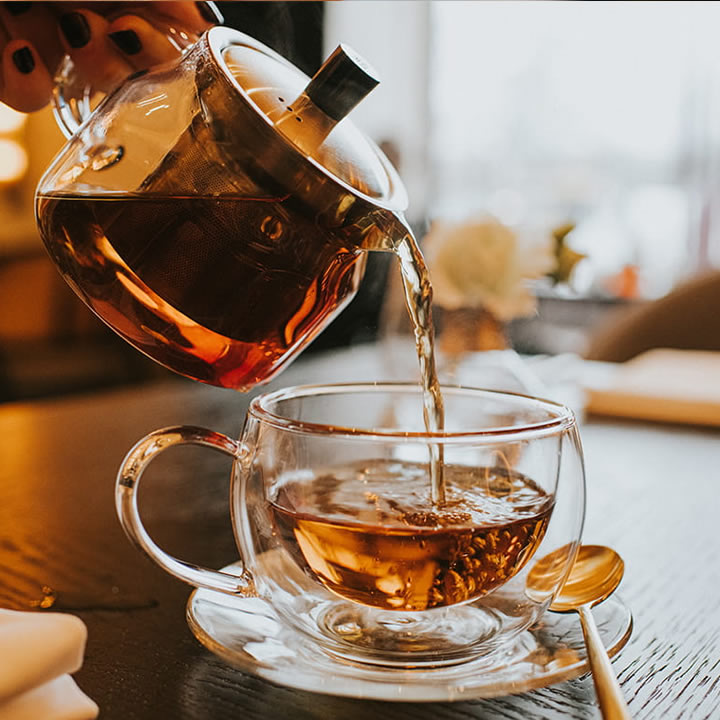You see, tea flavors are all about experimentation. We all have to imagine during the course of history, how many different leaves from a myriad of plants have been boiled or ground into a powder/paste in order to try and unlock the aroma and flavor contained within.
Right now, tea leaves come in five styles, which are broken down by how the leaves are dried, rolled, and made ready to drink: Black tea, Green tea, White tea, Herbal tea and Oolong tea.
Black tea, currently the most popular tea in the western hemisphere, is enjoyed both cold and hot.
It is mostly produced in India – with almost half of the world’s output. Black tea flavors tend to be bold and brisk. Despite its name, black tea has a reddish yellowish hue when brewed. Green tea leaves are preserved with heat which helps to preserve its mellow flavor.
Green tea is used heavily with flavored food recipes and other drinks, such as smoothies.
Japan and China produce the most green tea in the world.
Between the two countries, the main differences are that Chinese growing methods rely more on the natural surroundings (soil, environment) to impart the flavor of the tea, while Japanese methods are more controlled.
White tea tends to be more expensive than other teas because it is harvested by hand during a very short window in the year. Its flavor can range from mild, subtle, delicate, floral, grassy, honey, fruity, melon, peach, apricot, vanilla, chocolate, citrus, herby, and sweet.
White tea leaves are known to be fuzzy when dried.
Herbal teas encompasses the most aromatic and flavourful tastes in nature. This is because herbal teas are made using a combination of spices, flowers, bark, and leaves belonging to edible – and critically – non-tea plants.
In Europe and other areas of the world, herbal teas are commonly known as tisanes: leaf tisanes, flower tisanes, bark tisanes, root tisanes, fruit/berry tisane, and seed/spice tisanes happen to be the main types of herbal teas/tisanes that currently exist.
Oolong tea happens to have the widest range of flavors and colors than other categories of tea. Oolong varieties are harvested from mature leaves, allowing them to adopt the qualities of the places where they were grown, which gives off a unique flavor.
Greener oolong teas tend to have a rich, earthy taste, while darker varieties offer a more roasted flavor.
These five tea leaf styles spawned so many flavors which seemingly increase in number every few months.
Now there are tea flavors specifically for every occasion you could think of from breakfast and brunch to garden parties – some flavors can even serve as a part of the increasingly popular tea gifts set.
To that point, there are certain tea flavors that automatically fit a certain setting. So much so that the following catalog could be made. One that highlights the best flavors of tea that are societal acceptable to be brought by guests to a bachelorette party.
Best Tea Flavours For A Bachelorette Party
Earl Grey – Named after Charles, the 2nd Earl Grey and British Prime Minister from 1830 to 1834.
Earl Grey is a black tea base flavored with oil from the rind of bergamot orange. It has the sweet, floral, sour, and bitter flavor profile of bergamot citrus that blends perfectly with a bold and malty black tea.
Masala Chai – The Hindi name ‘Masala’ here refers to spices and “Chai” means tea. It is considered a mixed spice tea and has its roots on the Indian subcontinent and happens to be the most popular drink in India.
Because masala chai is made by brewing milk tea with spices, its flavor is predominantly determined by the type of spice used.
Whether it be sweet, savory, hot, or spicy.
Organic Peppermint – Known as one of the oldest medicinal herbs, Peppermint was originally from India before being distributed worldwide. Organic Peppermint flavor could be described as minty, cool, and refreshing.
Assam – Grown exclusively in the northeastern region in India where it got its name, the Assam tea plant is harvested two to three times a year. It is known to be used to make breakfast teas and has a deep, rich, full-bodied flavor with malty, earthy, bitter and astringent.
Rooibos – This plant is native to South Africa and its name means “red bush” in Afrikaans. Rooibos is known to have a mildly sweet, nutty, yet slightly floral flavor. Rooibos features an intense red color when in liquid form.
Ginger Lemon – The sour flavor of lemon and bitter tartness of ginger combine into a tea with a crisp, sharp flavor. Ginger Lemon tea is normally paired with honey for a little touch of sweetness.
Hibiscus – Made from dried parts of the hibiscus plant, is deep red in color. The roselle hibiscus plant used to make the tea likely originated from Africa and is often flavored with mint or ginger in countries on the western side of the continent.
Hibiscus tea is often compared to cranberries due to its tart yet sweet flavor.
Strawberry & Cream – A blend of strawberry, black tea, and caramel with creamy vanilla. This flavored fruit infusion highlights the tangy freshness of the strawberries while not leaving out the vanilla and carmel.
Rose Oolong – Is a floral blend made using organic roses and hand-rolled oolong tea.
The Rose Oolong has a smooth, creamy flavor, with a floral and toasty finish

